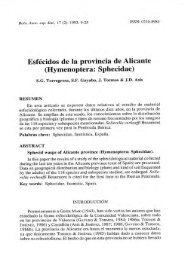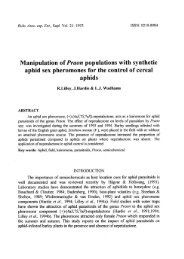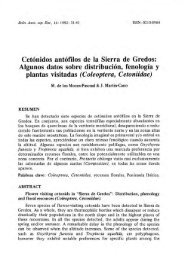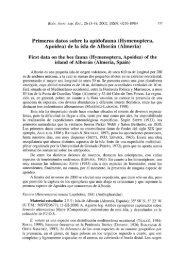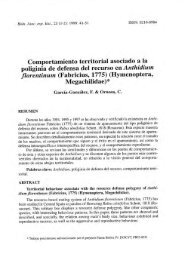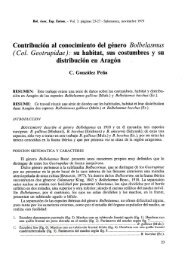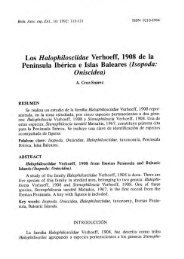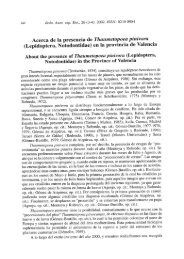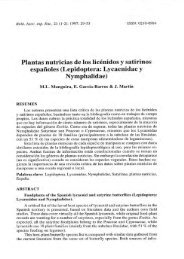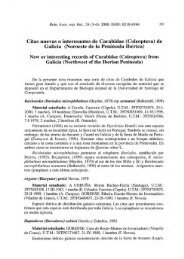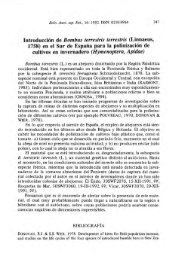Libro 1.indb
Libro 1.indb
Libro 1.indb
Create successful ePaper yourself
Turn your PDF publications into a flip-book with our unique Google optimized e-Paper software.
GALL MIDGES (DIPTERA: CECIDOMYIIDAE) OF THE IBERIAN PENINSULA 127<br />
Spurgia euphorbiae (Vallot, 1827)<br />
Cecidomyia capitigena Bremi, 1847<br />
Cecidomyia subpatula Bremi, 1847<br />
Dasineura subpatula (Bremi, 1847)<br />
Larvae cause large globular galls on vegetative tips of Euphorbia cyparissias L. and E. amygdaloides<br />
L. (Euphorbiaceae). Each gall is composed of many shortened deformed leaves.<br />
Occurrence: medium frequent (Fig. 119). References: TAVARES (1905a, 1921, 1931), BEL-<br />
LIDO et al. (2003). Distribution: European.<br />
Stefaniella brevipalpis Kieffer, 1898<br />
Larvae cause globular or fusiform swellings on stems, leaf petioles and mid veins of Atriplex<br />
halimus L. (Chenopodiaceae) with many long chambers, without membranes. Each chamber<br />
with one orange larva. Occurrence: very scarce (Fig. 119). Reference: TAVARES (1905a,<br />
1913). Distribution: Mediterranean.<br />
Stefaniella trinacriae Stefani, 1900<br />
Larvae cause fusiform woody galls, till the size of 20 mm, on Atriplex halimus L. (Chenopodiaceae).<br />
In the gall many chambers, in each chamber one yellow-whittish larva. The gall<br />
include Occurrence: scarce (Fig. 120). References: TAVARES (1931), SKUHRAVÁ et al.<br />
(1993), SKUHRAVÝ & SKUHRAVÁ (1999). Distribution: Mediterranean.<br />
Stefaniola bilobata (Kieffer, 1913)<br />
Dibaldratia bilobata Kieffer, 1913<br />
Larvae cause small elongated galls on buds of Salsola vermiculata L. (Chenopodiaceae). Buhl<br />
(1998) reported on parasites. Occurrence: scarce (Fig. 120). References: MÖHN (1971), SKUHRAVÁ<br />
et al. (1993), SKUHRAVÝ & SKUHRAVÁ (1999). Distribution: Mediterranean.<br />
Stefaniola gloma Möhn, 1971<br />
Larvae cause slight swellings of flower branches on Stefaniola vermiculata L. (Chenopodiaceae).<br />
Occurrence: very scarce (Fig. 121). Reference: MÖHN (1971). Distribution:<br />
Mediterranean.<br />
Stefaniola parva (Tavares, 1919)<br />
Salsolomyia parva Tavares, 1919<br />
Larvae live as inquilines in galls of Stefaniola salsolae (Tavares) on Salsola vermiculata<br />
L. (Chenopodiaceae). Occurrence: very scarce (Fig. 121). References: TAVARES (1919),<br />
SKUHRAVÁ et al. (1993), SKUHRAVÝ & SKUHRAVÁ (1999). Distribution: Mediterranean,<br />
endemic to the Iberian Peninsula.<br />
Stefaniola salsolae (Tavares, 1904)<br />
Stefaniella salsolae Tavares, 1904<br />
Larvae cause bud galls on Salsola vermiculata L. (= S. microphylla Mocq.) (Chenopodiaceae).<br />
The bud is changed into rosa-shaped fleshy gall, up to the size of 15-18 mm, inside with a<br />
chamber. The surface of the gall is covered with many small, hairy leaves. ASKEW (1994,<br />
1997) described several new species of parasitoids that were reared from galls of S. salsolae<br />
by Blasco-Zumeta. Occurrence: medium frequent (Fig. 122). References: TAVARES<br />
(1904b, 1914, 1918, 1919), MÖHN (1971), COGOLLUDO (1921), VILARRÚBIA (1936),<br />
SKUHRAVÁ et al. (1993), SKUHRAVÝ & SKUHRAVÁ (1999). Distribution: Mediterranean,<br />
endemic to the Iberian Peninsula.<br />
Boln. Asoc. esp. Ent., 30 (1-2): 93-159, 2006



